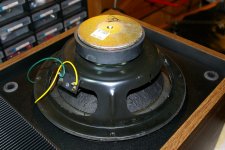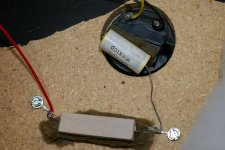It's different now with SMD, but solder was originally just to protect a mechanically sound connection
It's different now with SMD, but solder was originally just to protect a mechanically sound connection
Who told you that?
Because that's not true.
Someone must be dreaming up fantasies for others to read online.
It's different now with SMD, but solder was originally just to protect a mechanically sound connection
When I was doing city and guilds industrial electronics we were taught to make the joint mechanically sound before soldering it. This takes some strain off the soldered joint.
i.e. wrap wire around terminal post 180 degrees before soldering it.
Who told you that?
Because that's not true.
Someone must be dreaming up fantasies for others to read online.
I am not sure. I also was taught to make a mechanically sound connection first, which I understood to mean do not rely on the solder for mechanical strength as solder creeps under strain.. But I can certainly see how it could be interpreted as "protecting the mechanical connection".
I believe we all are thinking along the same lines..
Jn
Here's some wire wrapping that I encountered during the refoaming of the bass/mid driver surrounds in a pair of Bose 301 IIs from the 1980s.Wire wrapping is an interesting technique
I decided to leave well enough alone and did not to interfere with the joints. The renovated speakers sounded great!
Attachments
Before folks started doing shaker tests of soldered joints the method was to make a mechanical connection first and then solder it. Shaker tests showed the sharp angles would promote failures. So the preferred method became forming a nice fillet around the joint. That is why properly soldered PC Cards with smooth fillets and the wire trimmed above the joint is the practice today. If you do trim the connection too tight and nip the joint the practice is to reheat the joint so that it is smooth.
I have been buying locally made flux core solder in several different sizes. .015" for surface mount projects, .032" for PC Cards and small stuff and .062" for XLR connectors and such. I usually go through a few pounds of solder every year.
Before we let someone solder connections in the field they have to do 1,000 connectors at the bench correctly.
I have been buying locally made flux core solder in several different sizes. .015" for surface mount projects, .032" for PC Cards and small stuff and .062" for XLR connectors and such. I usually go through a few pounds of solder every year.
Before we let someone solder connections in the field they have to do 1,000 connectors at the bench correctly.
I am not sure. I also was taught to make a mechanically sound connection first, which I understood to mean do not rely on the solder for mechanical strength as solder creeps under strain.. But I can certainly see how it could be interpreted as "protecting the mechanical connection".
I believe we all are thinking along the same lines..
Jn
Indeed, properly mounting the component first is definitely the key to good assembly practices.
Then flowing solder to lock the assembly the assembly and provide a solid electrical connection.
Maybe 😉 Also if people considered that the primary function was to keep the contact gas tight and free from contamination they may worry less about the sound of solder 🙂I believe we all are thinking along the same lines..
I wrote a bit of a thesis on choosing solder. You can find it here: Choosing solder: A guide for hobbyists and pros alike.
I just picked up a 1 lb spool of 0.5 mm diameter 63/37 (Sn/Pb) solder with water-soluble flux from Mouser as I was running low.
Tom
I just picked up a 1 lb spool of 0.5 mm diameter 63/37 (Sn/Pb) solder with water-soluble flux from Mouser as I was running low.
Tom
I wrote a bit of a thesis on choosing solder. You can find it here: Choosing solder: A guide for hobbyists and pros alike.
I just picked up a 1 lb spool of 0.5 mm diameter 63/37 (Sn/Pb) solder with water-soluble flux from Mouser as I was running low.
Tom
Nice article. I normally only do prototypes by hand so I use 63/37 RMA and clean it when important or it has to last a while 🙂.
For leaded no-clean solder paste, I've had good luck with Kester EP256 63/37.
I use this and it is great 291726 | Multicore 0.7mm Wire Lead solder, +179degC Melting Point | RS Components not sure if you can get it where you are due to no conformance with ROHS.
It's gone up though (maybe because aussie dollar has dropped). I think I paid about $70 for my roll.
Tony.
It's gone up though (maybe because aussie dollar has dropped). I think I paid about $70 for my roll.
Tony.
I use 63/37 from MG Chemicals. Works a charm. Don't buy cheap Chinese solder. I have reason to believe it's reclaimed/recycled, and it's garbage.
Using old tin/lead no probs.Now can only buy lead free in local Scotland shops it is USELESS!!! totally USELESS. Now I have only a small amount of the proper stuff 60/40 left.Think I will be down to Sellotaping my components together next.
I wrote a bit of a thesis on choosing solder. You can find it here: Choosing solder: A guide for hobbyists and pros alike.
I just picked up a 1 lb spool of 0.5 mm diameter 63/37 (Sn/Pb) solder with water-soluble flux from Mouser as I was running low.
Tom
Good read and timely. I'm old-school from the 70s and 80s and we didn't follow some of the basic safety rules for lead and smoke exposure at those times, and anything more than 63/37 was too exotic to fool with. These things are relevant now and worthwhile for every DIYer to know. It's harder for old geezers like me to keep up with all these different and incompatible solders, so I feel an annual reread of materials is good practice.
Somewhere there's a video of soldering using a 'fake' solder, ie one that doesn;t match up to spec declared on it...
Ah! Here you go!
Ah! Here you go!
Somewhere there's a video of soldering using a 'fake' solder, ie one that doesn;t match up to spec declared on it...
Ah! Here you go!
Nice video, entertaining, yet also exposing in the way that electronics failures have been growing in the industry.
Lord knows, I've seen plenty of crappy frosted solder joints at the shop over the years.
I found it after getting extremely frustrated with (what I thought was) my own soldering skills. I thought I was just getting bloody awful at it/soldering iron was dying/crappy PCB's, etc etc
And then I bought some solder from the local store and all was well! There's a lot of dodgy solder out there it would seem...
And then I bought some solder from the local store and all was well! There's a lot of dodgy solder out there it would seem...
I found it after getting extremely frustrated with (what I thought was) my own soldering skills. I thought I was just getting bloody awful at it/soldering iron was dying/crappy PCB's, etc etc
And then I bought some solder from the local store and all was well! There's a lot of dodgy solder out there it would seem...
If you have old solder, just get a flux pen or paste, it'll make it work.
- Status
- Not open for further replies.
- Home
- Design & Build
- Parts
- Sick of crap solder


